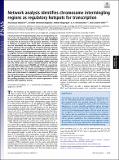Network analysis identifies chromosome intermingling regions as regulatory hotspots for transcription
Author(s)
Belyaeva, Anastasiya; Venkatachalapathy, Saradha; Nagarajan, Mallika; Shivashankar, G. V.; Uhler, Caroline
Download1708028115.full.pdf (1.508Mb)
PUBLISHER_POLICY
Publisher Policy
Article is made available in accordance with the publisher's policy and may be subject to US copyright law. Please refer to the publisher's site for terms of use.
Terms of use
Metadata
Show full item recordAbstract
The 3D structure of the genome plays a key role in regulatory control of the cell. Experimental methods such as high-throughput chromosome conformation capture (Hi-C) have been developed to probe the 3D structure of the genome. However, it remains a challenge to deduce from these data chromosome regions that are colocalized and coregulated. Here, we present an integrative approach that leverages 1D functional genomic features (e.g., epigenetic marks) with 3D interactions from Hi-C data to identify functional interchromosomal interactions. We construct a weighted network with 250-kb genomic regions as nodes and Hi-C interactions as edges, where the edge weights are given by the correlation between 1D genomic features. Individual interacting clusters are determined using weighted correlation clustering on the network. We show that intermingling regions generally fall into either active or inactive clusters based on the enrichment for RNA polymerase II (RNAPII) and H3K9me3, respectively. We show that active clusters are hotspots for transcription factor binding sites. We also validate our predictions experimentally by 3D fluorescence in situ hybridization (FISH) experiments and show that active RNAPII is enriched in predicted active clusters. Our method provides a general quantitative framework that couples 1D genomic features with 3D interactions from Hi-C to probe the guiding principles that link the spatial organization of the genome with regulatory control. Keywords: chromosome intermingling; Hi-C; network and clustering analysis; epigenetics; 3D FISH
Date issued
2017-12Department
Massachusetts Institute of Technology. Institute for Data, Systems, and Society; Massachusetts Institute of Technology. Laboratory for Information and Decision SystemsJournal
Proceedings of the National Academy of Sciences
Publisher
National Academy of Sciences (U.S.)
Citation
Belyaeva, Anastasiya et al. “Network Analysis Identifies Chromosome Intermingling Regions as Regulatory Hotspots for Transcription.” Proceedings of the National Academy of Sciences 114, 52 (December 2017): 13714–13719 © 2017 The Author(s)
Version: Final published version
ISSN
0027-8424
1091-6490